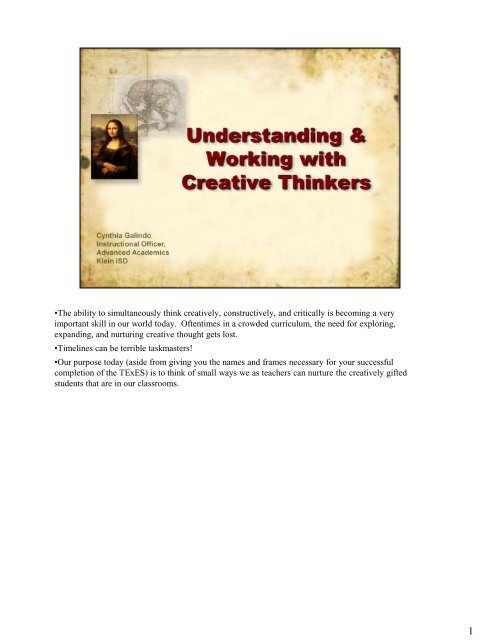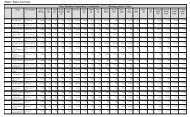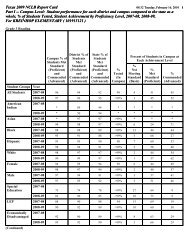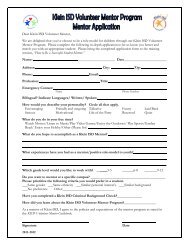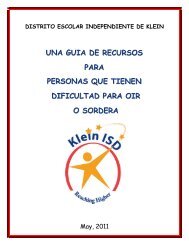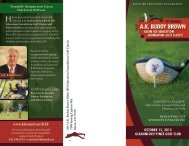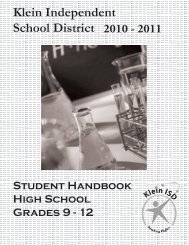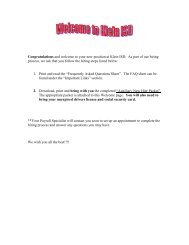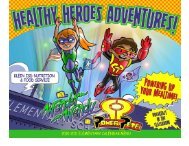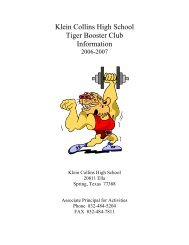Understanding & Working With Creative Thinkers - Klein ...
Understanding & Working With Creative Thinkers - Klein ...
Understanding & Working With Creative Thinkers - Klein ...
Create successful ePaper yourself
Turn your PDF publications into a flip-book with our unique Google optimized e-Paper software.
•Participants (including presenter) select a slip of paper and keep it secret. (Slips havean animal listed.) Frog, Fish, Chicken, Elephant, “Cheat-ah”, Peacock, Bumble Bee,Snake, Monkey•Once everyone has a slip of paper, each person must become that animal and mustfind their travel partner.•PARTICIPANTS MAY MAKE THEIR ANIMAL SOUNDS AND ASSUME THEMOVEMENTS OF THEIR ANIMAL, BUT THEY CANNOT POINT OR SPEAK5
• People can be trained and encouraged to develop creativity in that creativity issubject to catalytic events and conditions. But some people have more of what ittakes to be creative than others. (Creativity is based on some aptitude oraptitudes.)• Creativity is field specific (e.g.: A creative biologist but a so-so writer or a greatwriter may be an average or non-playing pianist.)• Keep in mind that the creatively gifted possess natural aesthetic abilities.6
•<strong>Creative</strong> people are not rigid: they look at things differently and from different pointsof view.•<strong>Creative</strong> people are aware of pressures to conform—to be like everybody else.•<strong>Creative</strong> thinking includes taking risks and making mistakes—the more creative theidea, the greater the risk.•<strong>Creative</strong> people play with ideas, consider lots of possibilities, and think analogically(picture; MTV videos as example)7
A study in the positive characteristics (and their negative perceptions) is vital tomaintaining a harmonious learning environment that fosters creative growth because ateacher‟s negative perspective/perception of a student and his/her behavior can bedetrimental and thwart the student‟s creative process. This can cause the student toshut down. Not that negative perceptions are conscious, of course…but perhaps we aseducators can begin to examine the actions of each child and assess if the irritatingtrait has a more palatable companion.8
•“Overactive: Physically hyperactive, twitches, nervous ticks, irritating habits•Disorganized: sloppy, unorganized with matters that are not deemed important•Capricious: fickle, quickly moves from one idea to another, mind wanders•Temperamental: Highly emotional, moody•Argumentative: argues his/her position, cynical, sarcastic, rebellious•Nonconformist: Questions authority/rules/laws•Impatient: Demanding, feels everyone else is out of step•Absent-minded: forgetful, not concerned with details•Stubborn: may not participate in class activities, aloof” (Reid, 1995)10
This list includes important creative abilities. Most have appeared elsewhere in the creativity literature, especiallyin Torrance‟s work.E. Paul Torrance from the University of Georgia, developed a test to measure divergent thinking. The test isknown as the TTCT which stands for the Torrence Test of <strong>Creative</strong> Thinking. The first four are the classicGuilford/Torrance: Fluency, Flexibility, Originality, and Elaboration which are measured by the Guilford testsand the Torrance Tests.Fluency: all about quantityFlexibility: all about different approaches to a problem or view a situation from several perspectivesOriginality: all about uniqueness and nonconformityElaboration: all about the ability to add details, develop, embellish, and implement a given ideaEvaluation: all about reflection and examining the ideaAnalogical Thinking is the ability to borrow ideas from one context and adapt them to another context, or theability to borrow a solution to one problem and transfer it to another.• Synthesis is the ability to see relationships, to combine parts into a workable, creative whole.• Transformation includes the ability to adopt something to a new use or to see new meanings…or maybe tochange one object or idea into another.• Resist premature closure is the ability to defer judgment and not jump on the first idea that comes along. Manystudents are deficient in this ability.• Aesthetic thinking is the sensitivity to and appreciation of beauty in art, design, and nature.• Some other creative abilities are the ability to see structure in chaos; anticipate consequences; and expertproblem solving skills. We will be talking about <strong>Creative</strong> Problem Solving or CPS later in the session.13
•Thanks to Dr. Saylor for sharing these “Thinking Metaphorically” examples.•Metaphorical Thinking is essentially the comparison of two basically different things.Metaphorical Thinking and Analogical Thinking fall in the category of Synecticswhich refers to the joining of unrelated elements. The significance of this concept tocreative thinking is the association of facts and ideas into new configurations ofinterpretation and understanding.16
So what is ½ of 8? Well yes it is 4BUT….•if I split 8 horizontally, I have 0 and•if I split 8 vertically, I have 3If I take the roman numeral 8 and split it horizontally•I could have 5 or 8I could also split the roman numeral 8 vertically and get 6 or 2.and finally, I could take the number 8 and split it at an angle and see a 7 embedded.17
•<strong>Creative</strong> people are able to visualize internally. To give you a low voltage sense ofinternal visualization, take a look at this airplane…..study it.•Is it coming towards you or going away from you?•A creative person will be able to visualize the movement of this plane and be able tohave it switch directions--at will.•Chances are when you first saw the picture, you saw it going in one direction andwith concentration, was able to switch it.•A creative person sometimes will see things clearly—an A-HA!....andsometimes…they will visualize it internally so that they can then see it clearly.•**Metaphorical thinking and internal visualization are but two examples of the widevariety of cognitive abilities that creative people have.18
(VanTassel-Baska, 2004)While feeling the harsh crack of the TAKS whip, we teachers can still INFUSEcreativity in to our lessons by incorporating these measures into the classroom. Whosays you can‟t prepare for the test or meet curricular guidelines in a creative way?Many creative teachers do this instinctively/intuitively, but these approaches tocreativity in the classroom can be conscious/deliberate.20
•Our goal as educators is to provide students with opportunities to hone their divergentand convergent thinking skills—to examine problems/issues/topics from multiplepoints of view and suspend judgment of ideas until they are out of-the-box, so-tospeak….forall to study and discuss. “The knowledge of these skills and the ability toevoke them with a degree of automaticity appears to be helpful to spawning creativityin several fields.” (Van Tassel-Baska, 2004)•The Wallas model was ground-breaking in its concept of introducing the “subconscious”into the idea-forming equation. I believe this model is the springboard forall the other creative thinking processes that came after it, including Osborne‟s “CPS”model.21
Examples:•What would you like to get out of life?•What are your goals, as yet unfilled?•What would you like to accomplish, to achieve?26
Examples:•Who is or should be involved?•What is or is not happening?•When does this or should this happen?•Where does or doesnt this occur?•Why does it or doesnt it happen?27
Examples•What is the real problem?•What is the main objective?•What do you really want to accomplish?•Whay do I want to do this?28
This is the divergent thinking, brainstorming stage.29
Sometimes an evaluation matrix is prepared with possible solutions listed on thevertical axis and criteria across the top. Each solution is rated according to criteriaand the ratings are then totaled to find the “best” idea.Examples of Criteria:•Will it work?•Is it legal?•Are the materials and technology available?•Are the costs acceptable?•Will the public accept it?•Will higher-level administrators accept it?30
SCAMPER is an acronym developed by Eberle (1977) who took someof Osborn’s key questions to enhance divergent and lateral thinkingand made them into an acronym.33
S: Substitute(a person, place, time or situation)What do you think would have happened if there had been a Crazy Scientist Bear insteadof Father Bear?C: Combine(bring together assorted ideas and situations)What would have happened if the three bears were returning from a reunion with relativeswho had escaped from a zoo where they had been badly treated by the zookeepers?A: Adapt(or adjust to suit a purpose)How might the story have changed if Goldilocks had had a leg in plaster andwas using crutches?M: Modify(for example, by changing the physical size or personality traits of some charactersor changing the setting)What would have happened if the bears had been cubs and much smaller than Goldilocks?P: Put to other uses(for example, put a different slant on the plot)What if Goldilocks was only pretending to be lost and was really looking for an excuse tobreak into other people‟s houses?E: Eliminatea feature of the storyHow might the story change if there were no Father Bear?R: Rearrangeor reverse the sequence of the storyWhat if Baby Bear had returned home before the others?34
•“Original ideas are statistically infrequent. …some creativity researchers prefer touse the term „unique‟ rather than „original.‟” (Torrance 1979)•What I have found interesting in my observations of teachers and even when I firstbegan to use “brainstorming” is that a time limit has always been imposed. Evenrecently, I‟ve heard teachers say “okay….let‟s brainstorm some ideas for fiveminutes…” According to Torrance, fresh, original, “unique” ideas come to surfacemuch later in the brainstorming session. Perhaps these time limits on creativity areproducts of working in an environment that is choked by time.•Not only must we give students ample time to produce ideas, but we must allow andencourage them to toy with the abstract—to play with the concept of uncertainty.They must be allowed to associate the imaginary with the real and make connectionsthat can be considered as plausible solutions. We must also tap into the creativeindividuals‟ emotional IQ. When proposing a problem we must stress the importanceof action! Again, due to lack of time, it can be difficult to follow through on a project,but the final step is important because the student needs to see their idea through toit‟s fruition.35
Stanish, 1986)Here is a wonderful opportunity for the brainstorming of novel ideas. “An extensionto this lesson is to list the ambiguities in life, e.g., what would be a more effectiveroad sign for „Dead End‟? What would be a more useful way of describing what atoadstool is? In other words, are „ends‟ really dead‟? Do toads actually sit on stools?”(Stanish, 1986).The idea here is to provide students with an opportunity to be still and think theunbelievable---and challenge them to make it believable! Imagine if a teacherassigned the game board activity and after the games are created, the students areasked to apply their games—their play to life. Wow! Also, if justice can be explainedin less than four sentences, have them create public service announcements via powerpoint to visually and/or musically depict their ideas. These can be submitted towww.civilrights.org with the possibility that they can be considered. 36
1. Painting: Salvador Dali “The Ship”2. From the Greek word “synecticos” which means the joining together of apparently unrelated elements.3. Synectics was developed by William JJ Gordon in 1961.4. Synectics provides an approach to creative thinking that depends on looking at, what appears on the surface asunrelated phenomenon and drawing relevant connections. Its main tools are analogies or metaphors.• Personal Analogy: identify yourself with a process or object; new perspectives are found by becoming part ofthe problem.“what would you be like if you were a captivating short story?”• Direct Analogy: compare associated elements from different areas“think of ways this problem is solved in nature by animals, flowers, bugs, etc…”• Symbolic Analogy: use an image to look at a problem; also called “compressed conflict” or “oxymoron”“careful haste” might be used by teachers or firefighters to stimulate ideas for quickly and safely evacuating abuilding• Fantasy Analogy: connect the known world with the fantastical. Gordon sees this type of analogy as aFreudian wish fulfillment.make the problem solve itself: “How can we make the hallways keep themselves clean?” “How can we getparents to want to attend open house?” Years ago….design engineers probably asked “How can wemake refrigerators defrost themselves? Ovens clean themselves?”37
1. What animal typifies your concept of freedom? (direct analogy)2. Put yourself in the place of the animal you have chosen. Be the thing! Describe whatmakes you feel and act with so much freedom. (personal analogy)3. Sum up your description of the animal you chose by listing the “free” and “unfree” part ofyour animal life.1. Free ___________________________________________2. Unfree _________________________________________4. Express each of these parts of your life in a single word. Put together these two wordsand refine them into a poetic, compressed conflict phrase.5. Circle the phrase you like best. Now write an essay about freedom, or write a poem aboutfreedom, or visually depict your new concept about freedom in either a painting or asculpture (any medium) or a dance or a write a musical creation using “NoteworthyComposer” software.** Can be used in connection with the study of “The Giver” or “The Holocaust”, “Diary of AnneFrank”, “The Hiding Place”, discussions of current events, etc…** Doesn‟t have to be an animal….Be <strong>Creative</strong>! Try a painting or a symphonic piece.38
Metacognition is the process of thinking about thinking. It is about knowing what we know and what we don‟tknow. John Flavell of Stanford University is regarded as a foundation researcher in metacognition anddescribes it as follows: "Metacognition refers to one's knowledge concerning one's own cognitive processes oranything related to them, e.g., the learning-relevant properties of information or data. For example, I amengaging in metacognition if I notice that I am having more trouble learning A than B; if it strikes me that Ishould double check C before accepting it as fact." (p 232). Metacognitive Aspects of Problem Solving,1976.Teachers implement metacognitive strategies almost daily. We just need to be alert about when we use them andconsciously model them for our students.1. Identifying "what you know" and "what you don't know"At the beginning of a research activity students need to make conscious decisions about their knowledge.Initially students write "What I already know about..." and "What I want to learn about...." As studentsresearch the topic, they will verify, clarify and expand, or replace with more accurate information, each oftheir initial statements.2. Talking about thinking• Talking about thinking is important because students need a thinking vocabulary. During planning andproblem-solving situations, teachers should think aloud so that students can follow demonstrated thinkingprocesses. Modeling and discussion develop the vocabulary students need for thinking and talking about theirown thinking. Labeling thinking processes when students use them is also important for student recognition ofthinking skills.• Paired problem-solving is another useful strategy. One student talks through a problem, describing histhinking processes. His partner listens and asks questions to help clarify thinking. Similarly, in reciprocalteaching (Palinscar, Ogle, Jones, Carr, & Ransom, 1986), small groups of students take turns playing teacher,asking questions, and clarifying and summarizing the material being studied.3. Keeping a thinking journalAnother means of developing metacognition is through the use of a journal or learning log. This is a diary inwhich students reflect upon their thinking, make note of their awareness of ambiguities and inconsistencies,and comment on how they have dealt with difficulties. This journal is a diary of process.4. Planning and self-regulation• Students must assume increasing responsibility for planning and regulating their learning. It is difficult forlearners to become self-directed when learning is planned and monitored by someone else.• Students can be taught to make plans for learning activities including estimating time requirements, organizing39
The concept of higher order thinking skills became a major educational agenda itemwith the publication of Bloom‟s taxonomy.40
The terms “Concrete” and “Abstract” refer to the world inwhich an individual lives. The Concrete world is physical andaction oriented with many “things” around. The “Abstract”world revolves around feelings, relationships and ideas. Theterms “Sequential” and “Random” refer to how you live yourlife. The Sequential individual prefers an orderly andpredictable life. The Random individual is spontaneous.41
Here‟s a list of skills labeled by style. I try to design my expectations to complementeach type of learner bya) The types of questions on a test/quizb) Socratic questioning in large groupsc) Type of “at-home” assignmentsd) Projects47
The purpose of this session was to better understand creativity and creatively giftedstudents as well as suggest ideas for stimulating creative growth.49


